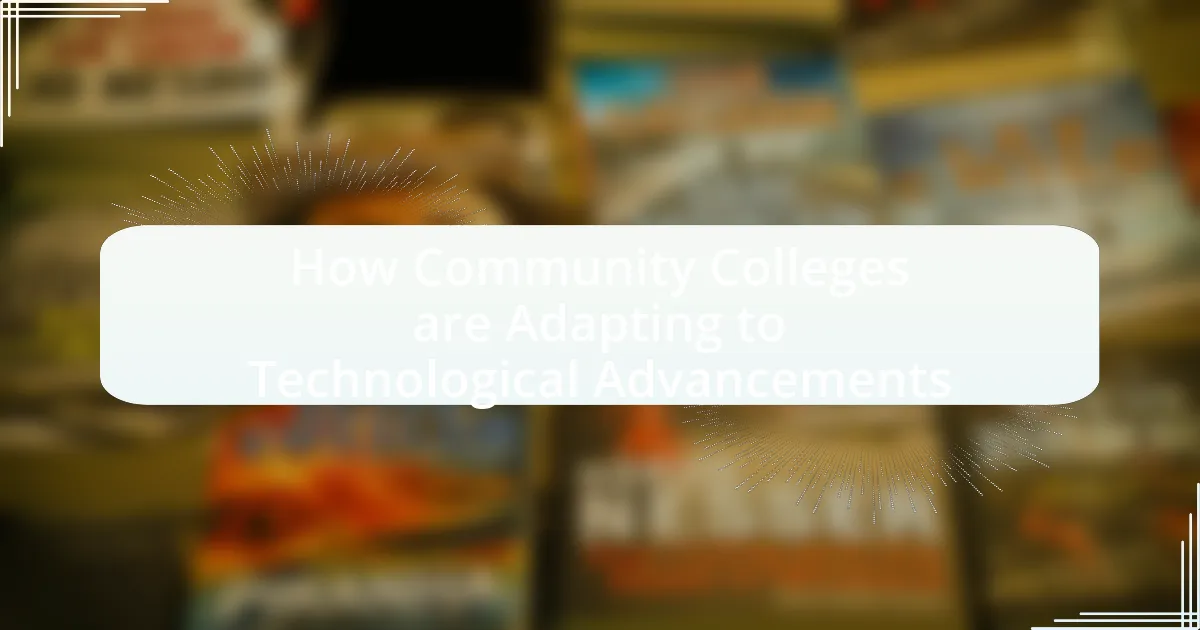Community colleges are increasingly adapting to technological advancements by integrating online learning platforms, enhancing digital resources, and offering training programs in emerging technologies. Key advancements impacting these institutions include Learning Management Systems, adaptive learning technologies, and data analytics, which facilitate personalized education and improve student engagement. Despite facing challenges such as limited funding and resource constraints, community colleges are implementing strategies to embrace technology, including partnerships with tech companies and access to funding opportunities. The outcomes of these adaptations are reflected in improved student performance, higher retention rates, and increased graduation rates, demonstrating the critical role of technology in modern education.

How are Community Colleges Responding to Technological Advancements?
Community colleges are responding to technological advancements by integrating online learning platforms and enhancing digital resources for students. Many institutions have adopted Learning Management Systems (LMS) like Canvas and Blackboard to facilitate remote education, which has become essential during the COVID-19 pandemic. According to a report by the American Association of Community Colleges, over 70% of community colleges have increased their investment in technology to improve student engagement and access to educational materials. Additionally, community colleges are offering training programs in emerging technologies, such as coding and data analytics, to prepare students for the evolving job market. This proactive approach ensures that community colleges remain relevant and effective in meeting the needs of their students in a rapidly changing technological landscape.
What are the key technological advancements impacting community colleges?
Key technological advancements impacting community colleges include online learning platforms, adaptive learning technologies, and data analytics. Online learning platforms, such as Canvas and Blackboard, enable flexible course delivery, allowing students to access materials anytime and anywhere, which has become essential, especially post-pandemic. Adaptive learning technologies personalize education by adjusting content and assessments based on individual student performance, enhancing engagement and success rates. Data analytics tools help institutions track student progress and identify at-risk students, facilitating timely interventions. According to a report by the American Association of Community Colleges, 70% of community colleges have adopted some form of online learning, demonstrating the significant shift towards technology in education.
How is online learning transforming community college education?
Online learning is transforming community college education by increasing accessibility and flexibility for students. This shift allows individuals who may have work or family commitments to pursue their education without the constraints of traditional classroom schedules. According to the National Center for Education Statistics, enrollment in online courses at community colleges has surged, with over 30% of students taking at least one online course in recent years. This trend demonstrates that online learning not only accommodates diverse student needs but also expands the reach of community colleges, enabling them to serve a broader population.
What role does artificial intelligence play in community college curricula?
Artificial intelligence plays a significant role in community college curricula by enhancing personalized learning experiences and improving administrative efficiency. Community colleges are increasingly integrating AI tools to tailor educational content to individual student needs, allowing for adaptive learning pathways that cater to diverse learning styles and paces. For instance, AI-driven platforms can analyze student performance data to provide real-time feedback and recommendations, which has been shown to improve student engagement and retention rates. Additionally, AI applications streamline administrative tasks such as enrollment management and advising, enabling faculty and staff to focus more on student support. This integration of AI in curricula reflects a broader trend in educational institutions to leverage technology for improved learning outcomes and operational effectiveness.
Why is it important for community colleges to adapt to technology?
It is important for community colleges to adapt to technology to enhance educational access and improve student outcomes. By integrating technology, community colleges can offer flexible learning options, such as online courses, which cater to diverse student needs and schedules. According to the National Center for Education Statistics, over 30% of community college students enrolled in at least one online course in 2020, highlighting the demand for technological integration in education. Additionally, technology facilitates personalized learning experiences through adaptive learning platforms, which can lead to higher retention and graduation rates. Therefore, adapting to technology is essential for community colleges to remain relevant and effectively serve their student populations.
What challenges do community colleges face in adopting new technologies?
Community colleges face significant challenges in adopting new technologies, primarily due to limited funding and resource constraints. Many community colleges operate on tight budgets, which restricts their ability to invest in the latest technological tools and infrastructure. According to a report by the American Association of Community Colleges, nearly 70% of community colleges cite budget limitations as a major barrier to technology adoption. Additionally, there is often a lack of technical support and training for faculty and staff, which hinders effective implementation and utilization of new technologies. This combination of financial and human resource challenges complicates the integration of innovative solutions in educational settings.
How does technological adaptation enhance student engagement?
Technological adaptation enhances student engagement by providing interactive and personalized learning experiences. For instance, the integration of online platforms and digital tools allows students to access resources at their convenience, fostering a more flexible learning environment. Research indicates that community colleges utilizing adaptive learning technologies have seen increased student participation and improved academic performance, as these tools cater to individual learning styles and paces. A study by the Bill & Melinda Gates Foundation found that institutions implementing technology-enhanced learning reported higher retention rates, demonstrating the positive impact of technological adaptation on student engagement.

What strategies are community colleges implementing to embrace technology?
Community colleges are implementing strategies such as integrating online learning platforms, enhancing digital literacy programs, and utilizing data analytics to improve student outcomes. These institutions are increasingly adopting Learning Management Systems (LMS) like Canvas and Blackboard to facilitate remote education, which has become essential during the COVID-19 pandemic. Additionally, community colleges are offering workshops and courses aimed at improving digital skills among both students and faculty, ensuring that all stakeholders are equipped to navigate technological tools effectively. Data analytics is also being leveraged to track student performance and engagement, allowing for tailored interventions that support academic success. These strategies collectively demonstrate a commitment to embracing technology in educational practices.
How are community colleges integrating technology into their programs?
Community colleges are integrating technology into their programs by adopting online learning platforms, utilizing digital resources, and incorporating advanced tools in the classroom. For instance, many community colleges have implemented Learning Management Systems (LMS) such as Canvas or Blackboard, which facilitate online course delivery and enhance student engagement. According to the American Association of Community Colleges, over 70% of community colleges offer online courses, reflecting a significant shift towards digital education. Additionally, colleges are using virtual labs and simulations in fields like healthcare and engineering to provide hands-on experience without the need for physical resources. This integration of technology not only improves accessibility for students but also prepares them for a workforce increasingly reliant on digital skills.
What types of training are being offered to faculty and staff?
Community colleges are offering various types of training to faculty and staff, including professional development workshops, technology integration training, and online teaching methodologies. These training programs aim to enhance teaching effectiveness and adapt to the evolving technological landscape in education. For instance, workshops often focus on the use of learning management systems and digital tools, which are essential for modern teaching practices. Additionally, many institutions provide ongoing support and resources to ensure faculty and staff remain proficient in emerging technologies, thereby improving student engagement and learning outcomes.
How are community colleges utilizing partnerships with tech companies?
Community colleges are utilizing partnerships with tech companies to enhance curriculum development, provide access to cutting-edge technology, and facilitate workforce training programs. These collaborations allow institutions to align educational offerings with industry needs, ensuring that students acquire relevant skills. For instance, partnerships with companies like Google and Microsoft have led to the integration of cloud computing and data analytics courses into community college programs, directly addressing the demand for skilled workers in these fields. Additionally, such partnerships often include internship opportunities, enabling students to gain practical experience while studying.
What funding opportunities exist for technological advancements in community colleges?
Funding opportunities for technological advancements in community colleges include federal grants, state funding programs, and private sector partnerships. The U.S. Department of Education offers various grant programs, such as the Strengthening Institutions Program, which provides financial support to enhance educational quality and institutional capacity. Additionally, state governments often allocate funds specifically for community colleges to upgrade technology and infrastructure, as seen in initiatives like California’s Strong Workforce Program, which invests in workforce development through technology. Furthermore, partnerships with private companies, such as tech firms, can lead to sponsorships and donations aimed at improving technological resources in community colleges. These funding avenues collectively support the integration of advanced technologies in educational settings, enhancing learning outcomes and workforce readiness.
How can community colleges access grants for technology upgrades?
Community colleges can access grants for technology upgrades by applying for federal, state, and private funding opportunities specifically designed for educational institutions. The U.S. Department of Education offers various grant programs, such as the Title III and Title V programs, which support technology enhancements in community colleges. Additionally, organizations like the Bill & Melinda Gates Foundation and the Lumina Foundation provide grants aimed at improving educational technology. According to the National Center for Education Statistics, community colleges have increasingly utilized these funding sources to modernize their facilities and enhance student learning experiences, demonstrating a commitment to adapting to technological advancements.
What role do state and federal programs play in supporting technology in education?
State and federal programs play a crucial role in supporting technology in education by providing funding, resources, and policy frameworks that enhance technological integration in learning environments. For instance, the federal E-Rate program offers discounts to schools and libraries for telecommunications and internet access, significantly improving connectivity in educational institutions. Additionally, state-level initiatives often allocate budgetary resources specifically for technology upgrades, training educators, and developing digital curricula, which are essential for adapting to technological advancements. These programs collectively ensure that educational institutions, particularly community colleges, can effectively implement and sustain technology-driven learning solutions.

What are the outcomes of technological adaptation in community colleges?
Technological adaptation in community colleges leads to improved student engagement and enhanced learning outcomes. By integrating digital tools and online resources, community colleges facilitate personalized learning experiences, which have been shown to increase retention rates. For instance, a study by the Community College Research Center found that institutions utilizing adaptive learning technologies reported a 10% increase in course completion rates. Additionally, technological adaptation enables greater access to educational resources, allowing students to engage with materials anytime and anywhere, thus promoting flexibility in learning.
How has student performance been affected by technological advancements?
Technological advancements have significantly improved student performance by enhancing access to educational resources and facilitating personalized learning experiences. For instance, the integration of online learning platforms allows students to access a wide range of materials and courses, leading to increased engagement and understanding of subjects. Research from the U.S. Department of Education indicates that students in online learning environments performed better, with a 1.5 times higher likelihood of achieving higher grades compared to traditional classroom settings. Additionally, adaptive learning technologies tailor educational content to individual learning paces, which has been shown to boost retention rates and overall academic success.
What metrics are used to measure the success of technology integration?
Metrics used to measure the success of technology integration include student engagement, retention rates, academic performance, and user satisfaction. Student engagement can be assessed through participation in online discussions and usage of digital resources, while retention rates indicate how many students continue their studies after technology implementation. Academic performance is measured through grades and completion rates, reflecting the effectiveness of technology in enhancing learning outcomes. User satisfaction is often gauged through surveys that collect feedback on the technology’s usability and impact on the educational experience. These metrics provide a comprehensive view of how well technology integration meets educational goals in community colleges.
How do technological advancements impact graduation rates?
Technological advancements positively impact graduation rates by enhancing access to educational resources and improving student engagement. For instance, the integration of online learning platforms allows students to access course materials anytime, leading to increased flexibility and the ability to balance studies with personal responsibilities. A study by the Community College Research Center found that students who utilized online resources had a 10% higher completion rate compared to those who did not. Additionally, technology facilitates personalized learning experiences through adaptive learning systems, which cater to individual student needs, further supporting higher graduation rates.
What best practices can community colleges adopt for successful technology integration?
Community colleges can adopt several best practices for successful technology integration, including comprehensive training for faculty, aligning technology with curriculum goals, and fostering a culture of continuous improvement. Faculty training ensures that instructors are proficient in using technology effectively, which enhances student engagement and learning outcomes. Aligning technology with curriculum goals ensures that the tools used directly support educational objectives, making learning more relevant and effective. Additionally, fostering a culture of continuous improvement encourages ongoing assessment and adaptation of technology use, allowing institutions to stay current with advancements and student needs. These practices are supported by studies indicating that effective technology integration leads to improved student performance and satisfaction.
How can community colleges ensure ongoing support for technological initiatives?
Community colleges can ensure ongoing support for technological initiatives by establishing dedicated funding sources and fostering partnerships with local businesses and technology firms. These institutions can allocate a portion of their budgets specifically for technology upgrades and training, ensuring that resources are consistently available. Additionally, collaboration with industry partners can provide access to the latest technologies and expertise, enhancing the educational experience. For instance, a report from the American Association of Community Colleges highlights that partnerships with local industries can lead to tailored training programs that meet workforce demands, thereby securing ongoing support for technological advancements.
What are the common pitfalls to avoid when implementing new technologies?
Common pitfalls to avoid when implementing new technologies include inadequate training, lack of stakeholder engagement, and insufficient infrastructure. Inadequate training can lead to underutilization of new tools, as employees may not know how to effectively use them. Lack of stakeholder engagement often results in resistance to change, as users may feel disconnected from the decision-making process. Insufficient infrastructure can hinder the successful deployment of technology, as outdated systems may not support new applications. According to a study by the Educause Review, 70% of technology initiatives fail due to these factors, highlighting the importance of addressing them during implementation.

Leave a Reply